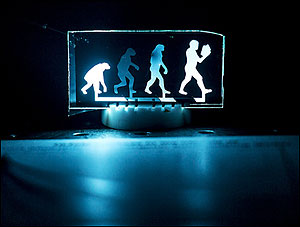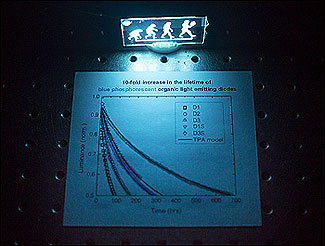ANN ARBOR, Mich., Sept. 25, 2014 — A new configuration extends the efficiency of blue organic light-emitting diodes (OLEDs) from about 5 percent to 20 percent, potentially leading to longer battery life in smartphones and lower power consumption for large screen televisions.
Phosphorescent OLEDs (PHOLEDs), which commonly emit red and green light, have demonstrated higher efficiencies than fluorescent OLEDs and are already used in many existing TVs and smartphones. However, blue PHOLEDs tend to have a shorter lifetime than their red or green counterparts.
In the study, conducted at the University of Michigan, a blue PHOLED consisting of a thin film of light-emitting material was sandwiched between two conductive layers: one for electrons and one for holes.

This model of the evolutionary chain in the physical model of the blue PHOLED was used to represent its ability to live an extended period of time. Images courtesy of Joseph Xu/University of Michigan.
Light was produced when electrons and holes met on the light-emitting molecules. However, damaging energy transfers occurred from electron-hole pairs that tended to accumulate near the electron-conducting layer.
To control this effect, the researchers arranged the molecules so they were concentrated instead near the hole-conducting layer. This drew electrons further into the material, spreading out the light-producing energy and reducing the damage. The new distribution was found to extend the lifetime of blue PHOLEDs by three times.
Next, the team split the design into two layers, halving the concentration of light-emitting molecules in each layer. This time, the new configuration increased the lifetime tenfold.

The efficiencies of blue OLEDs in various devices could jump from about 5 percent to 20 percent or more in the near future.
Previous experiments conducted by the team found that the high energies required to produce blue PHOLEDs can actually be more damaging when the brightness is increased to levels needed for displays or lighting.
“That early work showed why the blue PHOLED lifetime is short, but it didn’t provide a viable strategy for increasing the lifetime,” said Yifan Zhang, a UM researcher.
The researchers expect that “efficient blues will make a significant dent in power consumption for large-screen TVs and extend battery life in smartphones.”
The work was funded by Universal Display Corp. The research was published in Nature Communications (doi: 10.1038/ncomms6008).
For more information, visit www.umich.edu.